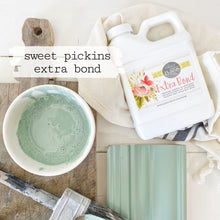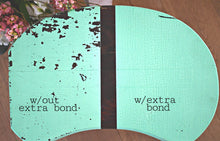You use extra bond IF you do NOT want your paint to chip off at all when painting a piece that already has some type of finish (meaning it is NOT raw wood.) If there is a finish on it and you are looking to achieve solid coverage- then you would use extra bond. Remember that with raw wood- you do NOT need to use extra bond since milk paint is not going to chip - it will actually get soaked into the raw wood and almost work like a stain. Ideal for when painting a dresser project because remember- you use Extra bond in a ratio that is one to two with your Milk Paint AFTER the Milk Paint has been thoroughly mixed with water. This new 100% natural product, when added to Milk Paint allows milk paint to be used on non-porous surfaces. We have found that the extra bond works best when used in EVERY coat if you want solid coverage (meaning no chips.) Since MMSMP has been taking off (woohoo!) - you, customers are painting it on just about everything and anything. From veneers to high gloss- to store bought pieces from Ikea and Target. We all know that considering your substrate is very important when deciding on which paint to use. It is very important to know that milk paint isn't a one size fits all paint. I did a little research and some of the newer pieces sold at KMart and Target are being treated with a flame retardant- this also makes it highly resistant to any types of paints adhering to it. Why extra bond in every coat? When you are using extra bond, you need to let each coat cure about 2 hours.
When you put the paint on, go for better coverage versus thinner coverage. If you use another coat, add the extra bond so it can bind to the previous coat. Straight milk paint with no bonder can act like water sitting on your paint for prolonged time. Water on any paint can deteriorate the bond and cause bubbling or chipping.
We LOVE milk paint for all the cool things it can do- but it has its limits like all paints do. Milk paint can be used on different surfaces such as painted walls, latex paint, oil paint, varnish, glass, metal etc. And it contains no VOCs.Milk Paint Extra bond allows Milk Paint to adhere to metal, glass and painted, varnished or lacquered surfaces. This extra bond is a water-based concentrated acrylic emulsion.We love that extra bond saves us the sanding and priming on our pieces, but there are still a few things to consider.
A. How shiny, sealed, or smooth is the surface? This is understanding your “substrate.” Milk paint, even with the extra bond added, needs to be absorbed, or able to “grab” onto something. This is true for all paints- super smooth and commercially sealed surfaces make any paint easily scratched off without some grip underneath. I say- the more shine- the more prime! Meaning- if it’s really shiny and smooth- I will do some scuffing of the surface, or use tsp, or both, in addition to my extra bond cure.
**Did you know that several surfaces are actually designed to resist anything from sticking to them?! I found this out with my kitchen cabinets- after cleaning them with mineral spirits, sanding, and bonding, I still got chipping. Whatever they were treated with and sealed with was formulated to prevent stains, and elements from sticking, and in my case, my paint as well! I have found the sure fit way to get stick- is to sand down to bare wood for them. More work, but better results.
B. What is your desired finish? If your desired finish is absolutely no chipping, distressing, or texture at all- it is best to default to some prep work, in addition to your extra bond.
C. How long are you letting it cure? Milk paint with bonding needs a minimum of 2 hours to cure before you put that 2nd coat on. However, the longer the cure- the better your chances are of getting good adhesion. Extra bond is 100% pure acrylic and needs time to cure.
D. How many coats are you layering on? What is your paint consistency? I try make my extra bond coat nice and creamy- slightly thicker even, with no clumps, a nice steady flow, and a smooth, good coverage in the first coat. The more you layer on top of the extra bond coat- the more likely you are to start to break down that bonding coat with the water in your subsequent coats and cause it to begin to chip.
Try using a fine grit (220 and up) sanding block in between coats- this will loosen anything that might want to chip before you paint again, smooth your surface, and prepare the way for another smooth coat on top.
Keep this as a quick guide when purchasing extra bond:
S (SHINE) How sealed, shiny, smooth is your piece? F (Finish) What’s your desired finish? Are you ok with chipping or want flawless coverage? C (CURE) 12-24 hour minimum on cure times for best results C (COAT) Nice consistency in your Coat of paint- and try to get good coverage in less coats vs. needing several coats to prevent unwanted chipping.
How to use this product:
Shake well before using. For optimum adhesion, clean the surface to be painted with T.S.P. and sand lightly to roughen the surface. Always test adhesion before applying to a large area.
To use with Milk Paint: Mix one part of extra bond to two parts of milk paint already mixed. For an even stronger grip, mix in equal parts. Mix the extra bond with all coats of paint for optimum adhesion.
To use as a primer for water-based paints: Apply a thin layer of extra bond with a paint brush or roller. Let dry for 2 hours before applying paint.
This product contains no solvents of VOC and is almost odorless. Clean brushes and tools with warm, soapy water. Protect from freezing.




